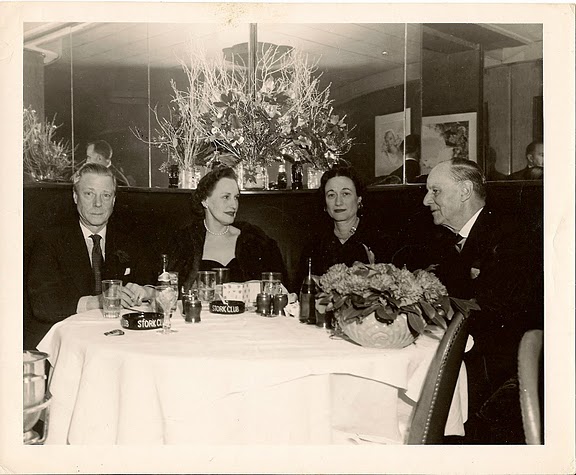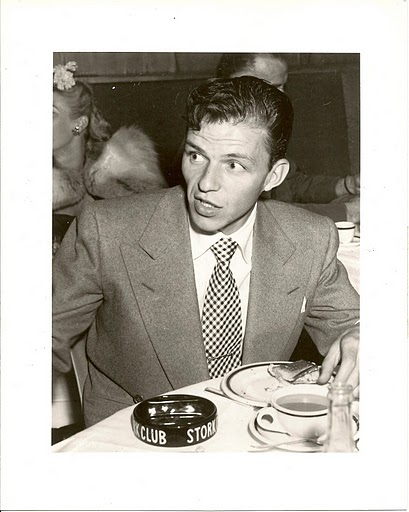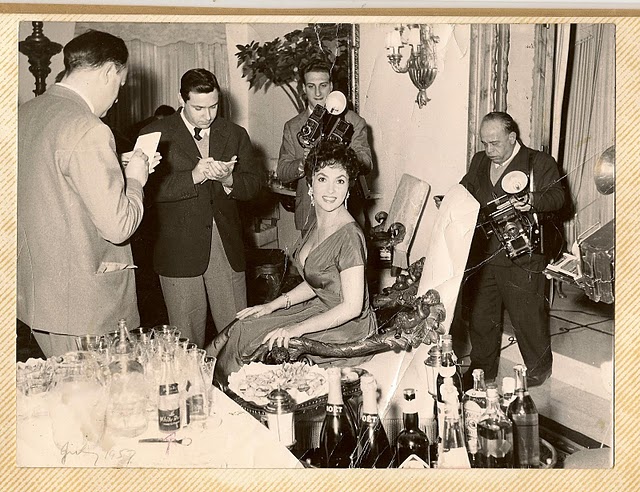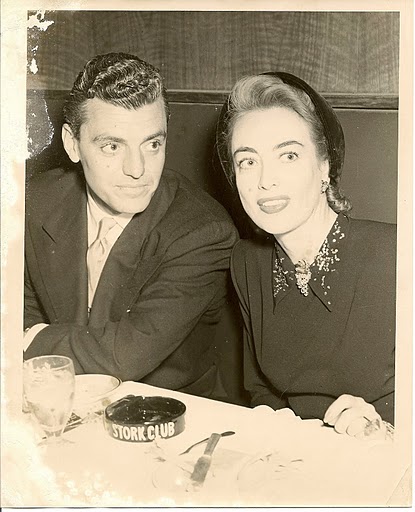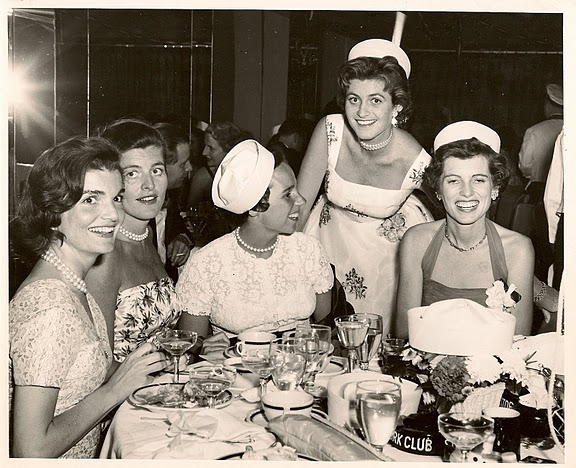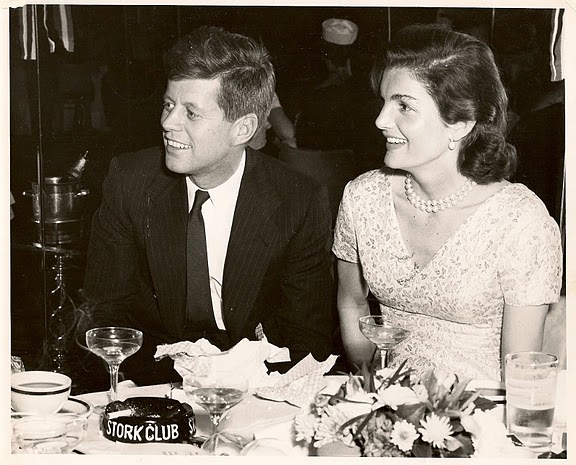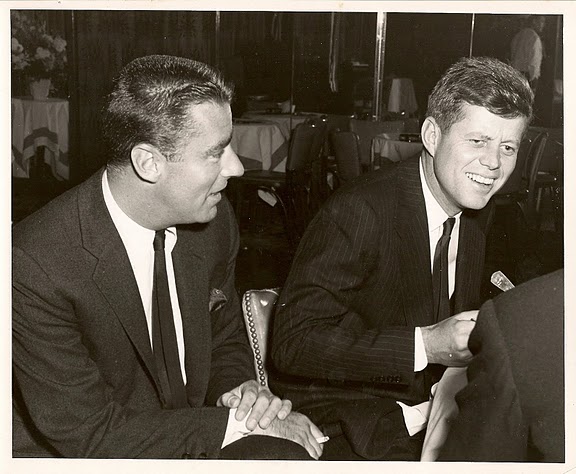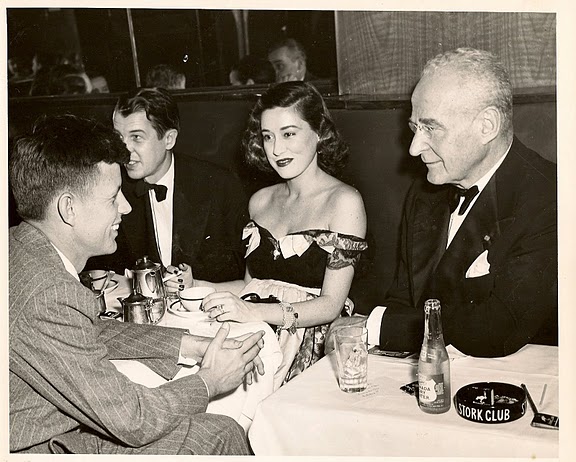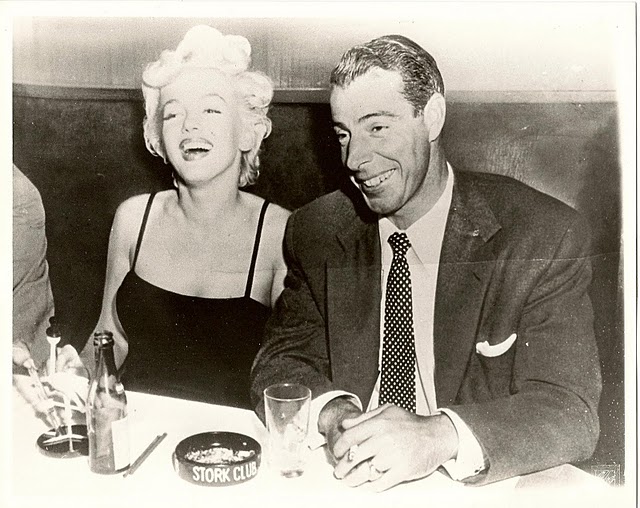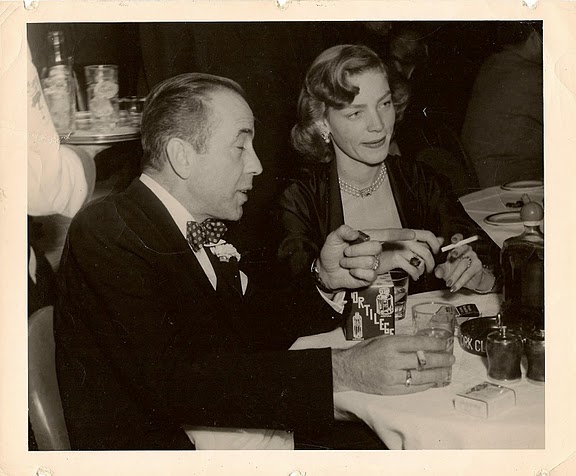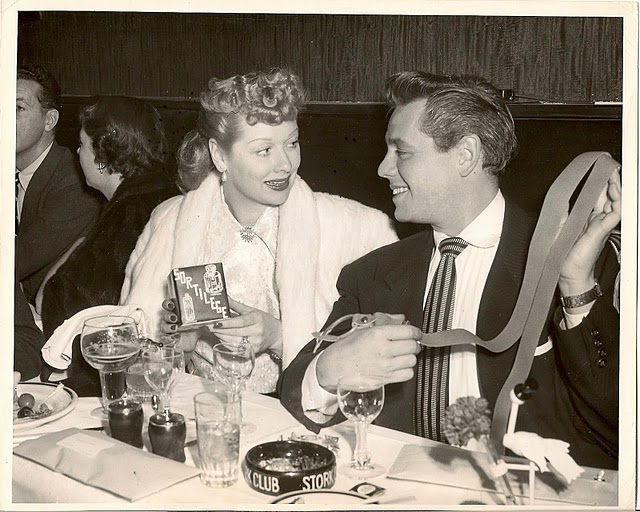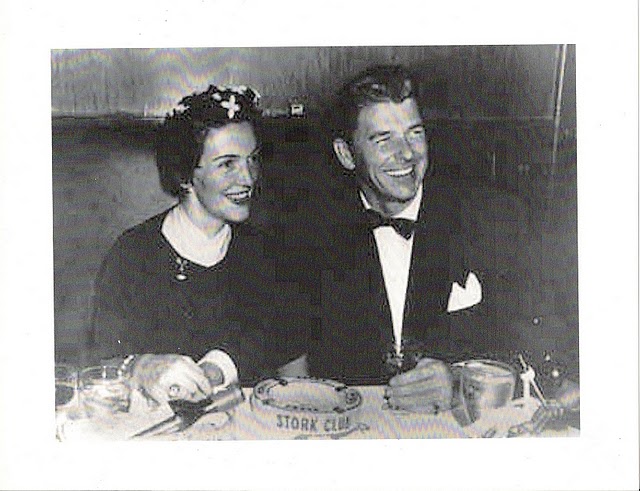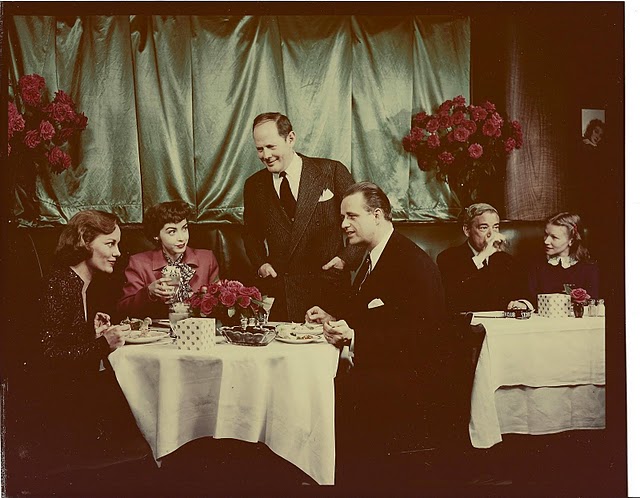

"I considered my function that of a connoisseur of the preposterous... I did have a fabulous time. I did drink more champagne and get to more dinner parties and general jollification than I would have in almost any other profession."
- Lucius Beebe, on having been a New York society columnist.
Lucius Beebe wrote about the Café Society - term coined by Maury Paul - in his column for the New York Herald Tribune throughout the Thirties and Forties. The people were the high society figures, politicians, film stars, sports celebrities, singers, and artists he encountered and caroused with in nightclubs and restaurants such as El Morocco, the 21 Club and the Stork Club. The column, This New York, was syndicated throughout the country and, along with the explosion of photojournalism, brought stories, gossip and images of the famous and their fabulous exploits to a mass audience hungry for more.
The emergence of the Café Society coincided with the eclectic and chaotic world of prohibition era nightlife. Where people - especially the rich and famous - had tended to socialize in their homes, the prohibition of alcohol led them to where they could get a drink. In New York, Sherman Billingsley made the party possible, first as an alleged bootlegger, then as the proprietor of the Stork Club, America´s most famous nightspot.
The congregation of the thirsty served by Billingsley selected themselves on the basis of their willingness to break a law, albeit a draconian one. In fact, the original Stork Club, which opened in 1929 at 132 West 58th Street, moved to another location after being shut down by prohibition agents in 1931. A year after the abolition of prohibition in 1933, it re-opened again at 3 East 53rd Street and remained there until it closed in 1965.
Refined style, uncluttered by the pretentious trappings of traditional night clubs, is what kept the glittering guest list returning night after night. If you were famous or important in the America of the Thirties, Forties, Fifties and early Sixties you were at the Stork Club, and there seem to have been very few exceptions. To name but a few, Jack and Jackie Kennedy, Marilyn Monroe, Ronald Reagan, Duke and Duchess of Windsor, Joe Dimaggio, Humphrey Bogart, Lauren Bacall, Ernest Hemingway, and Frank Sinatra rubbed shoulders with what seems unguarded naivety in comparison with the arch hyper-awareness of the modern celebrity. They simply came to be seen and to be seen socializing with people like them, famous, rich and in search of a party. It is hard today to illustrate the cultural significance of the Stork Club without drawing contemporaneous comparisons, picture Sarah Palin, Kobe Bryant and George Clooney grinning at a table together, with Beyonce and Jay-Z cutting a rug in the background.
Aided by the sense of euphoric anarchy that followed the abolition of Prohibition, Billingsley nurtured a paradox, of accessible exclusivity. Whilst the Club’s Cub Room and exclusive lounge and dining areas were the preserve of the celebrity clientele, the Stork Club itself was not. In fact, as noted in a Cosmopolitan article in 1947, “…the trade at the Stork consists mainly of nice people from the big and small towns of America whose names you never see in the Broadway columns”.
Never one miss a marketing trick, and in an act of generosity noteworthy in the lean days of Depression era America, Sherman Billingsley was known for giving away hundreds of thousands of dollars worth of gifts to his customers every year in high stakes prize draws; from cars to wrist watches, expensive jewelry and solid-gold cigarette lighters to dice and cigarette holders. He gave dolls to the little girls at lunchtime and official major-league baseballs to the boys. He also dispensed free Stork Club perfume and a lipstick - whose three shades were named after his daughters - to every lady in the powder room, and everything carried the Stork Club logo and unique design scheme. Examples of this early exercise in total brand awareness, such as the postcards he distributed in their thousands and the black and white Stork Club ashtrays that appear in every photograph of the place in its star laden heyday, are now sought after as rare collectors’ items.
As a result of his social philanthropy, glamorous clientele, and the journalistic exploits of Beebe and others such as newspaper columnist and radio commentator Walter Winchell, the Stork Club became synonymous with not only the dreamed-about lifestyles of the elite but also a household brand. By the 1950s, Billingsley was hosting his own television show, called The Stork Club, and his venue had featured as a location in a variety of movies and had also been cited by name in many more.
It is perhaps this idea of accessible exclusivity that marks this extraordinary venue as having left a lasting and ubiquitous impression on modern culture, like a film starlet’s lipstick mark on an elegant cigarette holder. Whilst the Stork Club helped to create the dizzying be-seen culture of public celebrity, it also fostered the notion that ordinary people had a stake in both the place and the lives of the stars who were preserving their names in lights by being photographed there. These stars were yours and mine, and so was the place where they went to shine.
- Benjamin Stewart
Stork Club
Website: www.storkclub.com
Photo Credit: Photos courtesy of Stork Club Enterprises.
- Lucius Beebe, on having been a New York society columnist.
Lucius Beebe wrote about the Café Society - term coined by Maury Paul - in his column for the New York Herald Tribune throughout the Thirties and Forties. The people were the high society figures, politicians, film stars, sports celebrities, singers, and artists he encountered and caroused with in nightclubs and restaurants such as El Morocco, the 21 Club and the Stork Club. The column, This New York, was syndicated throughout the country and, along with the explosion of photojournalism, brought stories, gossip and images of the famous and their fabulous exploits to a mass audience hungry for more.
The emergence of the Café Society coincided with the eclectic and chaotic world of prohibition era nightlife. Where people - especially the rich and famous - had tended to socialize in their homes, the prohibition of alcohol led them to where they could get a drink. In New York, Sherman Billingsley made the party possible, first as an alleged bootlegger, then as the proprietor of the Stork Club, America´s most famous nightspot.
The congregation of the thirsty served by Billingsley selected themselves on the basis of their willingness to break a law, albeit a draconian one. In fact, the original Stork Club, which opened in 1929 at 132 West 58th Street, moved to another location after being shut down by prohibition agents in 1931. A year after the abolition of prohibition in 1933, it re-opened again at 3 East 53rd Street and remained there until it closed in 1965.
Refined style, uncluttered by the pretentious trappings of traditional night clubs, is what kept the glittering guest list returning night after night. If you were famous or important in the America of the Thirties, Forties, Fifties and early Sixties you were at the Stork Club, and there seem to have been very few exceptions. To name but a few, Jack and Jackie Kennedy, Marilyn Monroe, Ronald Reagan, Duke and Duchess of Windsor, Joe Dimaggio, Humphrey Bogart, Lauren Bacall, Ernest Hemingway, and Frank Sinatra rubbed shoulders with what seems unguarded naivety in comparison with the arch hyper-awareness of the modern celebrity. They simply came to be seen and to be seen socializing with people like them, famous, rich and in search of a party. It is hard today to illustrate the cultural significance of the Stork Club without drawing contemporaneous comparisons, picture Sarah Palin, Kobe Bryant and George Clooney grinning at a table together, with Beyonce and Jay-Z cutting a rug in the background.
Aided by the sense of euphoric anarchy that followed the abolition of Prohibition, Billingsley nurtured a paradox, of accessible exclusivity. Whilst the Club’s Cub Room and exclusive lounge and dining areas were the preserve of the celebrity clientele, the Stork Club itself was not. In fact, as noted in a Cosmopolitan article in 1947, “…the trade at the Stork consists mainly of nice people from the big and small towns of America whose names you never see in the Broadway columns”.
Never one miss a marketing trick, and in an act of generosity noteworthy in the lean days of Depression era America, Sherman Billingsley was known for giving away hundreds of thousands of dollars worth of gifts to his customers every year in high stakes prize draws; from cars to wrist watches, expensive jewelry and solid-gold cigarette lighters to dice and cigarette holders. He gave dolls to the little girls at lunchtime and official major-league baseballs to the boys. He also dispensed free Stork Club perfume and a lipstick - whose three shades were named after his daughters - to every lady in the powder room, and everything carried the Stork Club logo and unique design scheme. Examples of this early exercise in total brand awareness, such as the postcards he distributed in their thousands and the black and white Stork Club ashtrays that appear in every photograph of the place in its star laden heyday, are now sought after as rare collectors’ items.
As a result of his social philanthropy, glamorous clientele, and the journalistic exploits of Beebe and others such as newspaper columnist and radio commentator Walter Winchell, the Stork Club became synonymous with not only the dreamed-about lifestyles of the elite but also a household brand. By the 1950s, Billingsley was hosting his own television show, called The Stork Club, and his venue had featured as a location in a variety of movies and had also been cited by name in many more.
It is perhaps this idea of accessible exclusivity that marks this extraordinary venue as having left a lasting and ubiquitous impression on modern culture, like a film starlet’s lipstick mark on an elegant cigarette holder. Whilst the Stork Club helped to create the dizzying be-seen culture of public celebrity, it also fostered the notion that ordinary people had a stake in both the place and the lives of the stars who were preserving their names in lights by being photographed there. These stars were yours and mine, and so was the place where they went to shine.
- Benjamin Stewart
Stork Club
Website: www.storkclub.com
Photo Credit: Photos courtesy of Stork Club Enterprises.
Stork Club,


|
|
|




|
| Present | ||
| Past |
| Hotels | ||
| Restaurants | ||
| Bars and Nightclubs | ||
| More |
| Hotels | ||
| Restaurants | ||
| Bars and Nightclubs | ||
| More |
| Hotels | ||
| Restaurants | ||
| Bars and Nightclubs | ||
| More |

